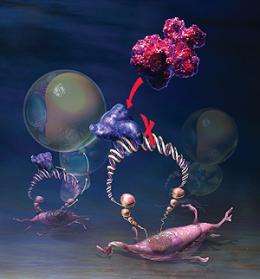Signal uncovered to help control when stem cells become fat cells

(PhysOrg.com) -- A research team at the School of Medicine and UC-San Francisco has uncovered a molecular signal that plays an important role in directing one type of “adult” stem cells to mature into fat cells.
The finding could help scientists design better drugs for type-2 diabetes and other diseases associated with obesity. And it may eventually lead to therapies for disorders of low muscle mass, such as pediatric muscular dystrophies or muscle degeneration in the elderly.
“We think the development of body composition is linked to stem cell fate,” said Brian Feldman, MD, PhD, an assistant professor of pediatrics and the senior author of the new study, which appeared March 18 in the Journal of Biological Chemistry. “The muscle and fat cell fates are pretty closely connected.”
One class of stem cells, the mesenchymal stem cells, gives rise to muscle, fat, cartilage and bone. Mesenchymal cells are considered “adult” stem cells; they are more specialized than embryonic stem cells, which are capable of differentiating into any cell in the body.
The new work suggests that blocking mesenchymal stem cells’ ability to advance to the fat cell fate may redirect the cells to form muscle instead.
“People might be willing to give up some of their fat in favor of developing some muscle,” Feldman said. “That would be the utopia — that we may be able to borrow some cells destined for the fat cell fate to try and treat disease.”
Feldman’s team uncovered a previously unknown role in mesenchymal stem cells for a gene called Per3. The gene produces a protein that inhibits the maturation of mesenchymal stem cells into fat cells. When the Per3 gene is switched off, a second gene that acts as the “master regulator” of the fat cell fate is dis-inhibited. This master regulator gene, called PPAR gamma, then sets in motion the chain of events that transforms the cell to a mature fat cell.
The researchers identified Per3’s role by delving into the actions of a class of hormones called glucocorticoids. Glucocorticoids include the naturally-occurring stress hormone cortisol and a variety of medications, such as prednisone, that are used to control asthma and autoimmune disease. Long-term use of glucocorticoid drugs has several undesirable side effects, notably increased risk for obesity and type-2 diabetes. And, in cell cultures, glucocorticoids have been shown to promote the transformation of mesenchymal stem cells to fat cells. The team showed that this happens because glucocorticoids switch off Per3, crippling its ability to inhibit the transformation of a stem cell to a fat cell.
The researchers also demonstrated that mice genetically engineered to have a defect in the Per3 gene had more fat and less lean mass than control mice. These Per3 knockout mice also had reduced glucose tolerance, a measurement of sugar metabolism that suggests they would be prone to type-2 diabetes.
Per3 had been previously known to play a minor role in the body’s circadian clock, which regulates daily rhythms. Based on its new work, Feldman’s team thinks Per3 is controlled in part by the main clock mechanism, suggesting that perturbations in the circadian clock might change how many stem cells become fat cells.
“The surprise is that it looks like the clock is sitting upstream of this gene, integrating our biological rhythms into these cascades that regulate stem cell fate,” Feldman said. Previous epidemiological studies have shown that people with perturbed circadian rhythms, such as people who work night shifts, are at elevated risk for obesity, he noted. “The implication of our work is that there is a molecular mechanism that can be used to test whether that’s more than an epidemiologic association.”
Provided by Stanford University Medical Center
















